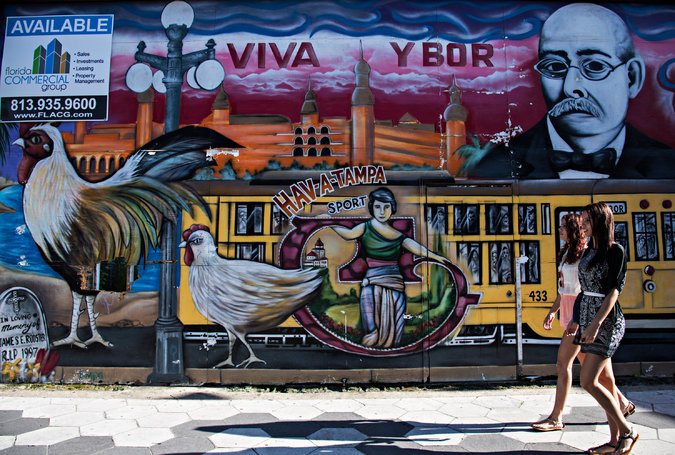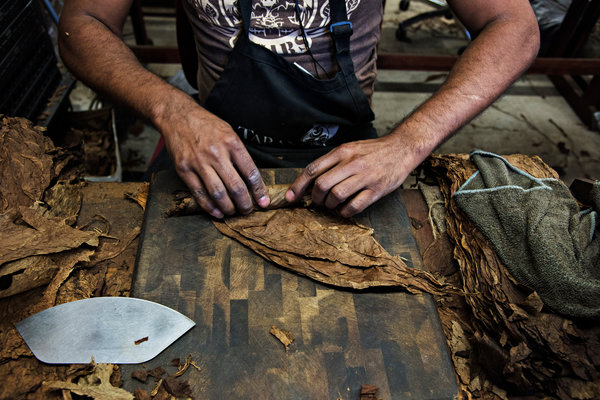
Going way back with Cubans, Tampa leads push forward
TAMPA, Fla. — Decades before Miami danced to a Cuban rhythm, Tampa’s Ybor City grew up and got rich to the sounds of Cuban-inflected Spanish as thousands of workers rolled cigars by day and plotted the island’s independence from Spain by night.
The city was America’s first touchstone for Cubans from the island. José Martí, the poet and the hero of Cuban independence, visited often during the 1890s to plan insurrection and to raise money from the successful cigar barons and their employees. A young Fidel Castro retraced Martí’s steps in the 1950s, hoping for a similar infusion of money and inspiration to boost his own revolution. Later on, exiles and former Cuban political prisoners streamed in, escaping Mr. Castro’s Communist grip.
Today, Tampa sees itself as pivotal to Cuba once again: The city is taking the lead in the Obama administration’s effort to rekindle diplomatic ties to Cuba, a move that runs counter to the anti-engagement orthodoxy of Miami and Florida’s state government.

In fostering closer ties to Cuba — a stance some here embraced long before President Obama’sDecember announcement — Tampa is positioning itself to one day reap the economic benefits of helping rebuild the crumbling country. Tampa’s port allows for a straight shot to Havana’s, giving it a major advantage if the United States lifts its economic embargo. Beyond that, city officials want to begin mending the historical kinship and once-powerful economic links between Cuba and Tampa that reach back more than six generations.
“You can’t write the history of Cuba without Tampa, and you can’t write the history of Tampa without Cuba,” said Patrick Manteiga, who runs La Gaceta, a daily newspaper. “This relationship between Tampa and Cuba means a lot here.”
La Gaceta — which publishes in English, Spanish and Italian — was founded in 1922 in Ybor City by Mr. Manteiga’s grandfather Victoriano, who was Cuban and once a lector who read to cigar workers as they worked.
The Cuban imprint is hard to miss in Tampa, where Cuban restaurants, busts of Martí and architectural gems, including the Cuban Club, are scattered across Ybor City, now a historic district. Cuba even owns a small plot of land in Ybor City, once the site of a house where Martí regularly stayed. A wealthy Cuban husband and wife bought the house as a memorial long after Martí’s death and donated it to Cuba in 1956. Today, the land is home to José Martí Park. And the deed for the land reads Estado Cubano, the Cuban state.
During its halcyon cigar days, Ybor City, named after its founder, a cigar manufacturer, brimmed with radical ideas and people. Strikes were common, mutual aid societies were abundant, women worked alongside men, blacks worked alongside Hispanics and whites, and Cubans raised money for revolutions at home.
Now Tampa officials are even pushing to open a Cuban Consulate here — something Miami leaders view with antipathy. In April, the Tampa City Council approved the idea of a consulate, as has the Greater Tampa Chamber of Commerce, a longtime advocate of strengthening ties between Cuba and Tampa.
The Council also voted to offer Tampa as the place where the United States and Cuba would sign any official accord. While some of Tampa’s 80,000 Cuban-Americans disagree with rapprochement on Cuba, most do not, officials said.
“We welcome the normalization and really believe it’s beneficial to people in Cuba,” said Councilwoman Yvonne Yolie Capin, a fourth-generation Cuban-American. “You go back a couple of years, and this would never have happened, but a lot has changed. Even though some are resistant, this is the time to do it.”
Standing inside his 4th of July Cafe in West Tampa, a hub for Cuban-Americans here, Armando Padrón Jr. agreed that a different approach was overdue. He arrived in the United States in 1979 with his sister, mother and father, once a political prisoner in Cuba.
Continue reading the main story
More Cuba Coverage
Highlights from The Times’s coverage of the historic developments in relations between the United States and Cuba.
“The top brass in Cuba doesn’t come to the table, you have to come to them,” Mr. Padrón, 52, said.
Tampa’s politicians have lobbied for closer ties for years. A turning point came in 2013 when Representative Kathy Castor, a Tampa Democrat, called for the end of the economic embargo and traveled to Cuba on a fact-finding trip. Calling the five-decade embargo a failure, Ms. Castor said she had decided the best way to help Cuba’s citizens and push the country toward more openness and democracy was through closer contact.
Her position played a role in Mr. Obama’s decision, political and business leaders said. “I think the Tampa community gave him greater political space and support to turn the page,” Ms. Castor added.
She is not the only Tampa political figure to visit Cuba. Former Representative Jim Davis, a Democrat, made a controversial trip in 2003, the first member of Florida’s congressional delegation to openly visit Communist Cuba. Members of the Tampa City Council, including Ms. Capin, also have visited. And Dick Greco, who was the mayor, traveled there in 2002 and sat down with Mr. Castro, which drew sharp rebukes back home.
More than a decade ago, the city’s business leaders began forging connections with Cuba, meeting with Cuban diplomats in Washington and inviting them here. This month, the Greater Tampa Chamber of Commerce is leading a third trip to Cuba. Long ago, Tampa imported tobacco and cattle from Cuba.
“We were smart to see around the bend,” said Bob Rohrlack, the chamber’s president and chief executive officer. “I wouldn’t expect that the first time I go into any country to come back with a bunch of contacts. We need to establish relationships there and grow business that way.”
But some Cuban-Americans in Tampa are rankled by the rush to cozy up to Cuba, an impoverished country that still imprisons and harasses citizens for their political views.
“Everybody is saying that a country that buys less than the city of Lakeland is going to provide riches to the city of Tampa,” said Ralph Fernandez, a well-known Cuban-American lawyer in Tampa who has represented former Cuban political prisoners. Calling the business elite here “carpetbaggers” with no moral compass, he said their efforts were misguided.
Tampa, though, is not Miami, which is certain to please Cuban officials. While anti-Castro sentiment still runs deep here, it is a more mellow strain, tempered by years of assimilation. Many of the Cubans who came to Tampa did so to find jobs long before the Castro revolution; they routinely traveled back and forth to the island.
By contrast, Miami’s Cuban-Americans thronged to the city fleeing Communism. They lost property, relatives and their homeland, which left an angry, bitter taste, one not easily dulled even by the decades.
“You can’t ignore a fundamental difference — that the Cubans in Tampa have gone through a much longer churning, maturing period than the Cubans in Miami,” said E. J. Salcines, a retired appellate judge from Tampa and an expert on the city’s Cuban history. “Give the Miami Cubans another 50 years, and they might be sounding more like Tampeño Cubans, but they are not there yet.”
(From: The New York Times)

